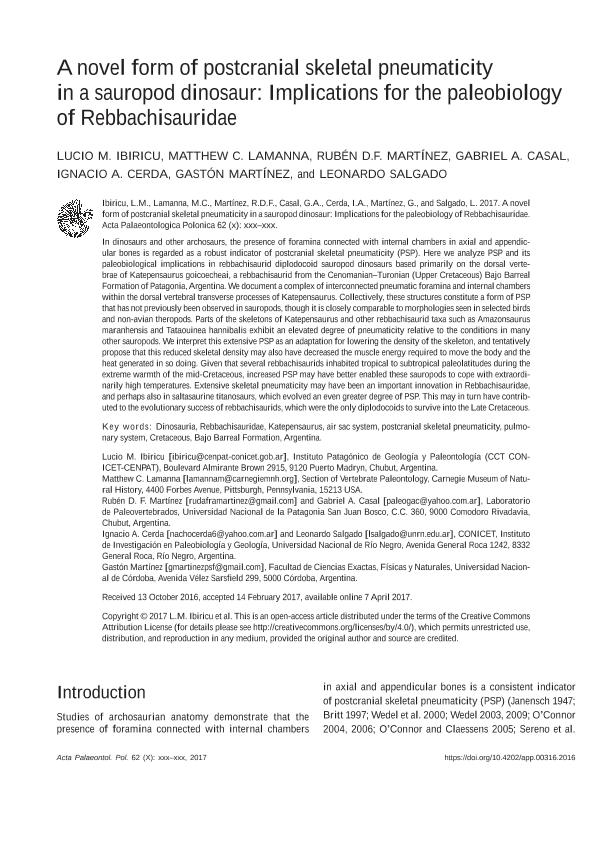Mostrar el registro sencillo del ítem
dc.contributor.author
Ibiricu, Lucio Manuel

dc.contributor.author
Lamanna, Matthew C.
dc.contributor.author
Martinez, Ruben D. F.
dc.contributor.author
Casal, Gabriel A.
dc.contributor.author
Cerda, Ignacio Alejandro

dc.contributor.author
Martínez, Gastón

dc.contributor.author
Salgado, Leonardo

dc.date.available
2018-10-24T14:12:20Z
dc.date.issued
2017-04
dc.identifier.citation
Ibiricu, Lucio Manuel; Lamanna, Matthew C.; Martinez, Ruben D. F.; Casal, Gabriel A.; Cerda, Ignacio Alejandro; et al.; A novel form of postcranial skeletal pneumaticity in a sauropod dinosaur: Implications for the paleobiology of Rebbachisauridae; Polish Academy of Sciences. Institute of Paleobiology; Acta Palaeontologica Polonica; 62; 2; 4-2017; 221-236
dc.identifier.issn
0567-7920
dc.identifier.uri
http://hdl.handle.net/11336/62982
dc.description.abstract
In dinosaurs and other archosaurs, the presence of foramina connected with internal chambers in axial and appendicular bones is regarded as a robust indicator of postcranial skeletal pneumaticity (PSP). Here we analyze PSP and its paleobiological implications in rebbachisaurid diplodocoid sauropod dinosaurs based primarily on the dorsal vertebrae of Katepensaurus goicoecheai, a rebbachisaurid from the Cenomanian-Turonian (Upper Cretaceous) Bajo Barreal Formation of Patagonia, Argentina. We document a complex of interconnected pneumatic foramina and internal chambers within the dorsal vertebral transverse processes of Katepensaurus. Collectively, these structures constitute a form of PSP that has not previously been observed in sauropods, though it is closely comparable to morphologies seen in selected birds and non-avian theropods. Parts of the skeletons of Katepensaurus and other rebbachisaurid taxa such as Amazonsaurus maranhensis and Tataouinea hannibalis exhibit an elevated degree of pneumaticity relative to the conditions in many other sauropods. We interpret this extensive PSP as an adaptation for lowering the density of the skeleton, and tentatively propose that this reduced skeletal density may also have decreased the muscle energy required to move the body and the heat generated in so doing. Given that several rebbachisaurids inhabited tropical to subtropical paleolatitudes during the extreme warmth of the mid-Cretaceous, increased PSP may have better enabled these sauropods to cope with extraordinarily high temperatures. Extensive skeletal pneumaticity may have been an important innovation in Rebbachisauridae, and perhaps also in saltasaurine titanosaurs, which evolved an even greater degree of PSP. This may in turn have contributed to the evolutionary success of rebbachisaurids, which were the only diplodocoids to survive into the Late Cretaceous.
dc.format
application/pdf
dc.language.iso
eng
dc.publisher
Polish Academy of Sciences. Institute of Paleobiology

dc.rights
info:eu-repo/semantics/openAccess
dc.rights.uri
https://creativecommons.org/licenses/by-nc-sa/2.5/ar/
dc.subject
Air Sac System
dc.subject
Argentina
dc.subject
Bajo Barreal Formation
dc.subject
Cretaceous
dc.subject
Dinosauria
dc.subject
Katepensaurus
dc.subject
Postcranial Skeletal Pneumaticity
dc.subject
Pulmonary System
dc.subject
Rebbachisauridae
dc.subject.classification
Meteorología y Ciencias Atmosféricas

dc.subject.classification
Ciencias de la Tierra y relacionadas con el Medio Ambiente

dc.subject.classification
CIENCIAS NATURALES Y EXACTAS

dc.title
A novel form of postcranial skeletal pneumaticity in a sauropod dinosaur: Implications for the paleobiology of Rebbachisauridae
dc.type
info:eu-repo/semantics/article
dc.type
info:ar-repo/semantics/artículo
dc.type
info:eu-repo/semantics/publishedVersion
dc.date.updated
2018-10-22T17:31:39Z
dc.identifier.eissn
1732-2421
dc.journal.volume
62
dc.journal.number
2
dc.journal.pagination
221-236
dc.journal.pais
Polonia

dc.journal.ciudad
Varsovia
dc.description.fil
Fil: Ibiricu, Lucio Manuel. Consejo Nacional de Investigaciones Científicas y Técnicas. Centro Científico Tecnológico Conicet - Centro Nacional Patagónico. Instituto Patagónico de Geología y Paleontología; Argentina
dc.description.fil
Fil: Lamanna, Matthew C.. Carnegie Museum Of Natural History; Estados Unidos
dc.description.fil
Fil: Martinez, Ruben D. F.. Universidad Nacional de la Patagonia ; Argentina
dc.description.fil
Fil: Casal, Gabriel A.. Universidad Nacional de la Patagonia ; Argentina
dc.description.fil
Fil: Cerda, Ignacio Alejandro. Consejo Nacional de Investigaciones Científicas y Técnicas. Centro Científico Tecnológico Conicet - Patagonia Norte. Instituto de Investigación en Paleobiología y Geología; Argentina
dc.description.fil
Fil: Martínez, Gastón. Universidad Nacional de Córdoba; Argentina. Consejo Nacional de Investigaciones Científicas y Técnicas; Argentina
dc.description.fil
Fil: Salgado, Leonardo. Consejo Nacional de Investigaciones Científicas y Técnicas. Centro Científico Tecnológico Conicet - Patagonia Norte. Instituto de Investigación en Paleobiología y Geología; Argentina
dc.journal.title
Acta Palaeontologica Polonica

dc.relation.alternativeid
info:eu-repo/semantics/altIdentifier/url/https://www.app.pan.pl/article/item/app003162016.html
dc.relation.alternativeid
info:eu-repo/semantics/altIdentifier/doi/https://doi.org/10.4202/app.00316.2016
Archivos asociados
